By Heidi Sutton
Teamwork was the key ingredient at this year’s Junior Iron Chef competition. The annual event, now in its 7th year, was held on March 9 at Whole Foods in Lake Grove. Hosted by Cornell Cooperative Extension of Suffolk County, the one-day cooking challenge, described as “part ‘Chopped,’ part ‘Iron Chef,’ and part ‘Food Network Challenge,’” gave middle and high school students the opportunity to work in groups of three to five to complete a delicious dish of their choosing in under an hour. Fifteen teams from all over Long Island competed this year for the ultimate title of Junior Iron Chef.
“This is an amazing event,” said DJ Anthony Cafaro, from WEHM, who has served as the event’s emcee since its inception. “It’s cool to see some repeat competitors from year’s past and it’s awesome to see a lot of new competitors here,” he said.
The purpose of the event was to encourage budding chefs to learn new cooking skills and lead a healthier lifestyle while promoting the use of local food to support our local farmers and environment. Each team was required to create a new healthy vegetarian or vegan based recipe that used local ingredients and could be easily implemented into school cafeteria menus.
“This is the seventh year I’ve done this and by far this was the greatest year with the best flavors,” said Cafaro as he tasted all the dishes.
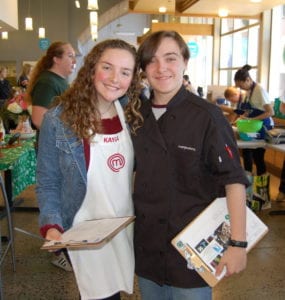
Among the 11 judges who graded the dishes based on flavor, health value, creativity and presentation was 14-year-old William Connor from Northport, a past contestant on “Chopped Junior” on the Food Network, and 13-year-old Kayla Mitchell of Center Moriches who was a contestant on the third season of “MasterChef Junior” on Fox Broadcasting.
High school teams were given a secret ingredient at the last minute, a Sumo Citrus, to incorporate into their dish. Some chose to use the peel, others the juice. While the teams created their dishes, Cafaro kept the ever-growing crowd entertained with fun trivia and giveaways to places like the Long Island Aquarium and concerts.
While the judges deliberated, Executive Chef Jason Keubler and Anthony Cafaro visited each station, tasting each dish and giving feedback to the aspiring chefs. While Cafaro raved over everything that was put in front of him, Keubler gave positive feedback, from “These eggs are spot on,” “Flavors are very balanced,” “Great knife skills,” to pointing out the cleanliness of their workstation and asking them what their greatest obstacle was. “It’s all about teamwork and it shows in your work,” he complimented one team.
First place in the middle school division went to Team G.O.A.T. (Greatest Of All Time) from Seneca Middle School in Holbrook. Students Leah Ferraro, Sofia Iacono, Jacqueline Volo and Gianna Scolaro, guided by coach Robert Frontino, won the judges over with their creative Caribbean Breakfast Salad, which was comprised of cinnamon sugared French toast, grilled pineapple and arugula salad with goat cheese, topped with a raspberry vinaigrette dressing.
 “That’s insanely good,” drooled Cafaro as he reached for a napkin. “The cinnamon and the goat cheese go so well together,” agreed Chef Jason. “The color is super vibrant, the spiciness goes with the sweetness with nice textures. Beautiful presentation,” he said adding that he was impressed by how nicely they worked together “just like in a professional kitchen.”
“That’s insanely good,” drooled Cafaro as he reached for a napkin. “The cinnamon and the goat cheese go so well together,” agreed Chef Jason. “The color is super vibrant, the spiciness goes with the sweetness with nice textures. Beautiful presentation,” he said adding that he was impressed by how nicely they worked together “just like in a professional kitchen.”
Second place was awarded to The 3 Breakfasteers from Suffolk County 4-H Trailblazers of Yaphank for their Vanilla Fruit Crepes filled with whipped cream and diced strawberries and garnished with blueberries. Corey Burke, Alexis Vladikin, Nora Nemickas and coach Nicole Vickovich made up the team.
The Junior Porters from Greenport Union Free School District grabbed third place for their Mediterranean Breakfast Crepe with an Herbed Whipped Cream. Coached by Katherine Ryan, Rocio Azama, DeShawn Solla, Aleyana Gungar, Ayania Smith and Brynn Dinizio were awarded for their healthy crepe stuffed with baby spinach, sundried tomatoes, black olives and low-fat feta cheese.
Team Almost Master Chef from Sachem North High School in Ronkonkoma captured first place in the high school division. Kaitlyn Seitz, Hailey McKishi, Kayla Salvate and Victoria Corcaran, under the guidance of coach Lindsey Shelhorse, impressed the judges with their Brunch For Lunch Chilaquiles dish featuring homemade tortilla shells topped with fried egg, cheese, onion and cilantro.
Second place was awarded to the Greenport High School’s Bacon Bits – Jhon Ramirez, Tommy Tsaveras, Colin Rossetti, Mateo Arias and Charles Staples – for their Gyro Style Veggie Burger on Whole Wheat Pita, which was served with sautéed onions and tzatziki sauce with a cucumber garnish. The team was coached by Marianne Ladalia.
The Salt Shakers from the Suffolk County 4-H Trailblazers garnered third place. Olivia Unger and Lexington Carrera, under the guidance of coach Adrienne Unger, were given high marks for their crispy Potato Latkes topped with a dollop of sour cream and garnished with chives and scallions.
The Mise en Place (everything in its place) awards were presented to Seneca Middle School’s Taco Bellas (Emma Bollinger, Amanda Madigan, Madeline Turano and Adrianna Sigler with coach Robert Frontino) and Almost Master Chef.
The Public Presentation awards, for the team with the best poster/informational display and judge presentation, were presented to G.O.A.T. and Bacon Bits.
“The kids today were just tremendous,” said Vito Minei, executive director of Cornell Cooperative Extension of Suffolk County. “This is truly a Long Island Junior Iron Chef competition with teams coming all the way from Floral Park, Franklin Square and Greenport,” he added. “I want to thank all the parents and families.You should be proud. These kids were fabulous. They all practiced teamwork and each child had an opportunity to shine.”
 Brunch for Lunch Chilaquiles
Brunch for Lunch Chilaquiles
by Team Almost Top Chef, first place winners in the high school division
Ingredients
Tortilla Shell
10.5 ounces of all purpose flour
1 teaspoon baking powder
½ teaspoon salt
¼ cup vegetable oil
7-8 ounces of hot water (110-120F)
Sauce
Diced yellow onion
Diced and seeded jalapeño
3 tablespoons olive oil
2 cloves of garlic
1 tablespoon ground chili powder
1 teaspoon ground cumin
3 tablespoons flour
½ teaspoon garlic powder
¼ teaspoon dried oregano
¼ teaspoon salt, to taste
Pinch of cinnamon
Can of tomato paste
2 cups vegetable broth
1 teaspoon distilled white vinegar
Freshly ground black pepper, to taste
Filling and Topping Ingredients
Can of drained and rinsed black beans
12 oz. Fiesta Blend Cheese (365 Everyday Value Brand)
3 oz. cotija
Diced red onion
Cilantro
6 Eggs
Directions
Instructions for sauce
- Sauté the diced onion and jalapenos to the pan.
- Crush and smash cloves of garlic and salt and add to the onion mixture. Add the cumin and chili powder. Add the flour, oregano, garlic powder and salt into a small bowl and place it near the stove.
- Add the flour/spice mixture.
- While whisking constantly, cook until fragrant and slightly deepened in color, about 1 minute. Whisk the tomato paste into the mixture, then slowly pour in the broth while whisking constantly to remove any lumps.
- Raise heat to medium-high and bring the mixture to a simmer, then reduce heat as necessary to maintain a gentle simmer. Cook, whisking often, for about 5 to 7 minutes.
- Remove from heat, then whisk in the vinegar and season to taste with a generous amount of freshly ground black pepper. Add more salt, if necessary.
- Stir in the black beans
Instructions for tortillas
To make the dough: In a medium-sized bowl, whisk together the flour, baking powder, and salt. Pour in the lesser amount of hot water (plus the oil, if you’re using it), and stir briskly with a fork or whisk to bring the dough together into a shaggy dough.Turn the dough out onto a lightly floured counter and knead briefly, just until the dough forms a ball. Divide the dough into 8 pieces. Round the pieces into balls, flatten slightly, and allow them to rest, covered, for about 15 minutes. Preheat ungreased cast iron griddle or skillet over medium high heat, about 400°F. Working with one piece of dough at a time, roll into a round about 8″ in diameter. Keep the remaining dough covered while you work. Fry the tortilla in the ungreased pan for about 30 seconds on each side. Then cut into wedges and fry them and add salt to taste.
Assembling
Fry the eggs. Layer the fried tortilla shell with spoonful of sauce and cheese. Top with the fried egg, more cheese, dice red onion and cilantro.
 Caribbean Breakfast Salad
Caribbean Breakfast Salad
By Team G.O.A.T., first place winners in the middle school division
Ingredients
16 oz of arugula
8 oz of goat cheese
2 boxes of raspberries (7 oz. each)
1 pineapple
1 loaf challah bread
1/2 cup olive oil
1/2 tsp Dijon mustard
1/4 tsp. oregano
1/4 cup white vinegar
1/2 cup brown sugar
1/3 cup white sugar
1/4 cinnamon
4 eggs
2 tbsp honey
Directions
Challah French Toast
Preheat skillet to 350 degrees. Mix eggs in large bowl. In a separate bowl mix sugars and cinnamon. Dip the challah bread slices into egg mixture and then the sugar blend. Cook until golden brown, 3 to 4 minutes.
Arugula Salad
Mix oil, vinegar, honey and mustard and whip until blended. Strain the raspberries. Add raspberry juice to oil mixture until smooth to taste. Toss arugula, whole raspberries and cheese together with liquid dressing.
Pineapple
Cut outside skin of pineapple. Cut one inch horizontal slices. Dip in sugar mixture. Grill on both sides for 2 to 3 minutes.
All photos by Heidi Sutton





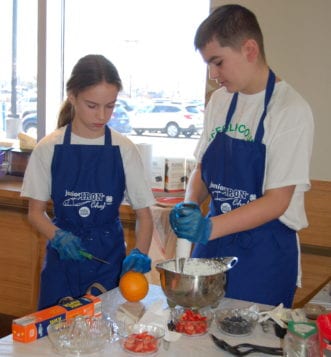
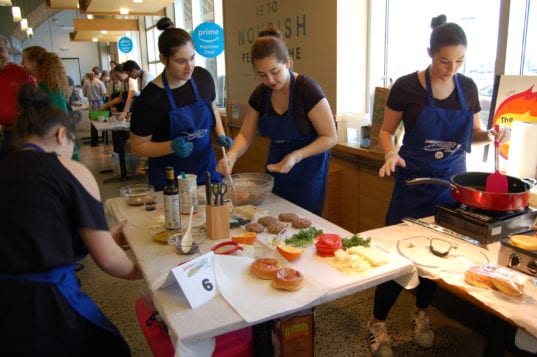








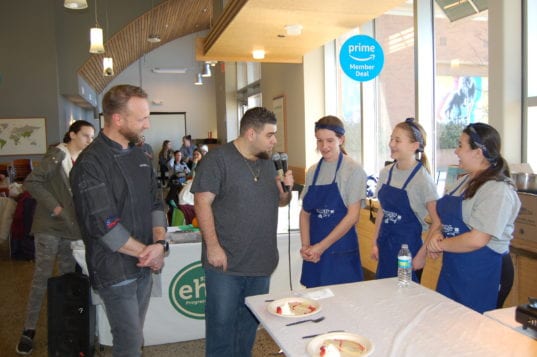



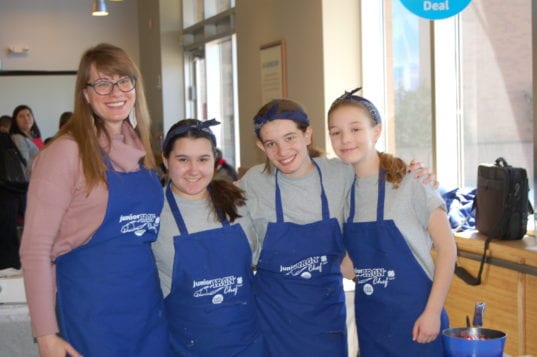

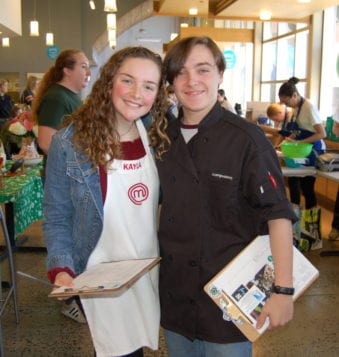

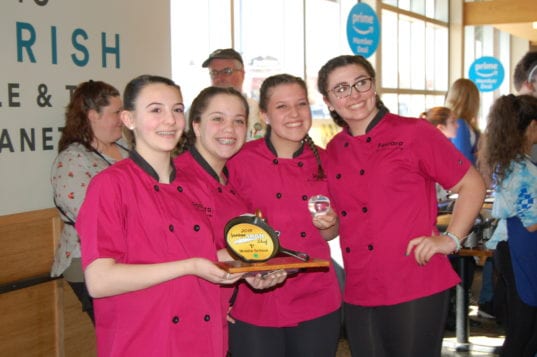

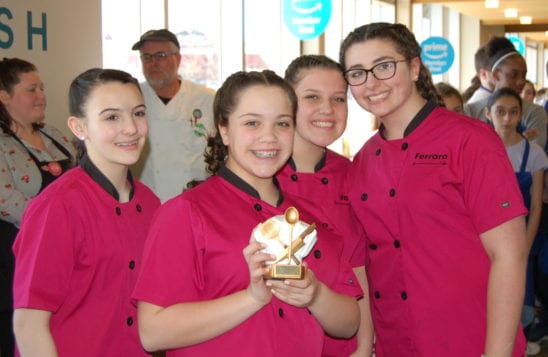






 Numbers help us track the time of year. Even a warm day in February doesn’t make it July, just as a cold day in June doesn’t turn the calendar to November.
Numbers help us track the time of year. Even a warm day in February doesn’t make it July, just as a cold day in June doesn’t turn the calendar to November.











































